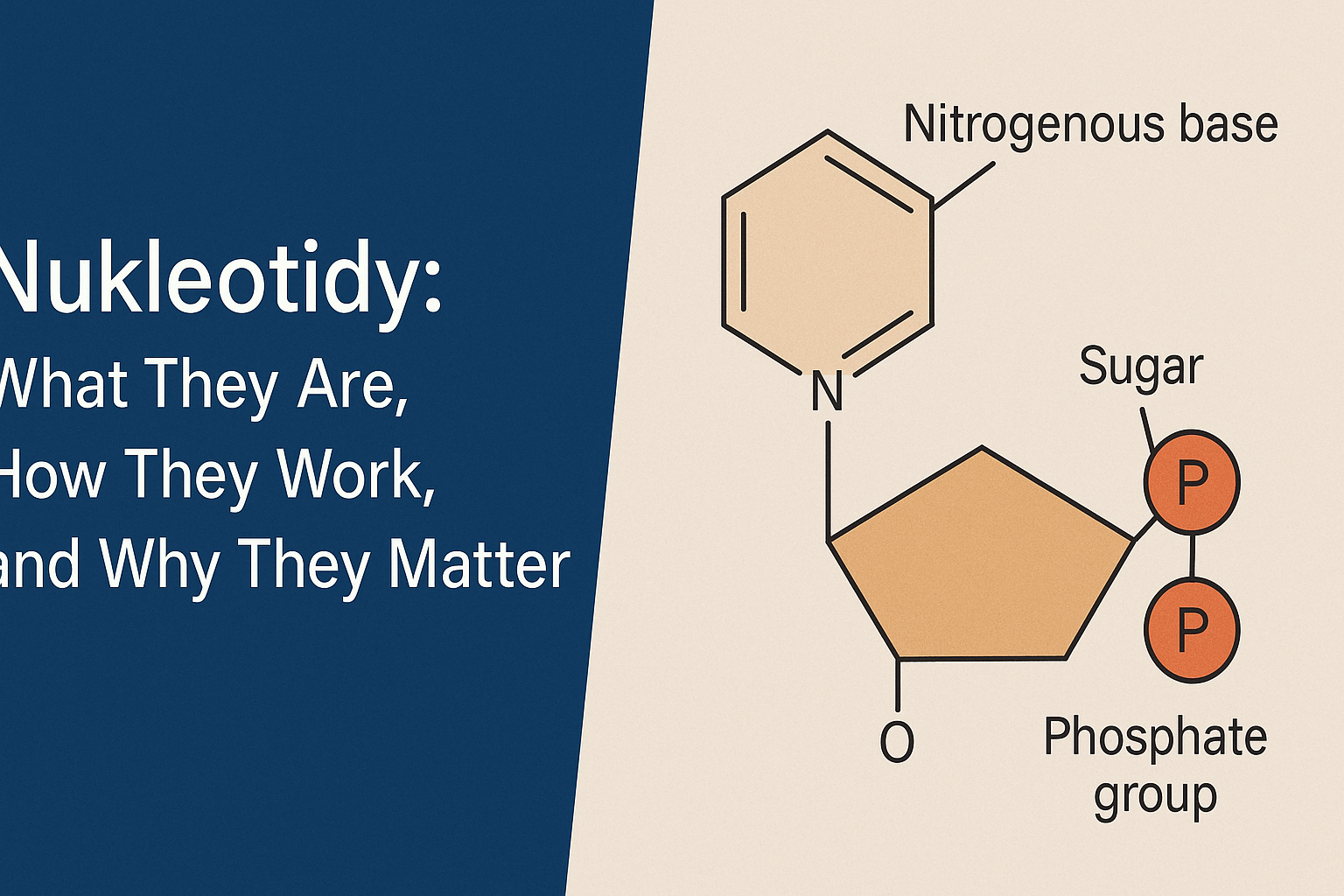Introduction
Nukleotidy (nucleotides) are essential molecules in all living cells. They form the building blocks of our genetic material (DNA, RNA), help store energy, and enable key signalling processes. In this article, we explore what nukleotidy are, their structure, functions, types, synthesis, and how they impact health and disease.
What Are Nukleotidy?
A nukleotid (singular) is a chemical compound made of three parts:
- A nitrogenous base (nukleová báze) — either a purine (adenine, guanine) or a pyrimidine (cytosine, thymine or uracil).
- A sugar molecule — either ribose (in RNA) or deoxyribose (in DNA).
- One or more phosphate groups.
These three together make one nucleotide. Chains of nucleotides form nucleic acids (DNA, RNA), which carry genetic information.
Structure of Nukleotidy
Nitrogenous Bases
- Purines: adenine (A) and guanine (G). They have a double-ring structure.
- Pyrimidines: cytosine (C), thymine (T) in DNA, and uracil (U) in RNA. They have a single-ring structure.
Sugar Component
- Ribose: sugar for RNA nucleotides. Has an –OH (hydroxyl) group on its 2’ carbon.
- Deoxyribose: sugar for DNA nucleotides. Lacks an –OH on the 2’ carbon (hence “deoxy”).
Phosphate Groups
- Can have one, two, or three phosphate groups. The number changes the energy and role of the nucleotide (monophosphate, diphosphate, triphosphate).
- Phosphates link nucleotides together via sugar-phosphate backbone in DNA/RNA.
Types and Classification of Nukleotidy
By Sugar Type
- Ribonucleotidy (ribonucleotides): sugar is ribose. Found in RNA.
- Deoxyribonucleotidy (deoxyribonucleotides): sugar is deoxyribose. Found in DNA.
By Number of Phosphates
- Monophosphate (one phosphate) ‒ low energy, structural part of backbone.
- Diphosphate (two phosphates)
- Triphosphate (three phosphates) ‒ high energy, often used in energy transfer (e.g. ATP).
By Function / Special Types
- Standard nucleotides: those used in normal DNA/RNA sequences (A, T, G, C, U).
- Modified nucleotides: altered in one part (base, sugar or phosphate) for special roles (signal molecules, lab tags, etc.).
How Nukleotidy Work: Functions in Cells
Building Genetic Material
- DNA and RNA are long chains (polymers) of nucleotides. The order of nucleotides encodes genetic information.
- Base pairing (A-T or A-U, C-G) enables replication and transcription.
Energy Currency
- Nucleoside triphosphates, such as ATP (adenosine triphosphate), supply energy for many biochemical reactions.
- When a phosphate bond is broken, energy is released, powering things like muscle contraction, active transport, molecular motors.
Cell Signalling and Regulation
- Some nukleotidy become second messengers. For example, cyclic AMP (cAMP) helps transmit signals inside cells.
- Cofactors: some nucleotides are parts of coenzymes (e.g. NAD, FAD) that assist in metabolic enzymes.
Biosynthesis and Breakdown
Synthesis of Nukleotidy
- De novo pathway: Cells build nucleotides from small starting molecules like amino acids, CO₂, and ribose-5-phosphate.
- Salvage pathway: Cells recycle bases and nucleosides from degraded nucleic acids.
Degradation
- When nucleic acids break down, their nucleotides are also broken. The bases may be excreted or reused. Purines degrade to uric acid in many organisms.
- Pyrimidines are usually broken down fully to CO₂, water, and ammonia.
Importance of Nukleotidy in Health and Disease
Genetic Disorders and Mutations
- Errors in DNA (wrong nucleotide inserted, or altered base) can cause mutations. Some mutations cause disease.
Drug Targets
- Many antiviral or anticancer drugs are nucleotide analogues (they mimic real nucleotides). When cells or viruses use them, they disrupt DNA/RNA replication.
Nutrition and Supplements
- While most cells can make nucleotides, rapidly dividing cells (e.g. immune cells, gut lining) demand more. In some cases, diet helps supply extra nucleotides.
- Research suggests dietary nucleotides can play roles in gut health, immunity, and recovery from stress.
How Nukleotidy Are Named (Nomenclature)
- The name depends on the base + sugar + number of phosphate groups.
- Abbreviations: AMP = adenosine monophosphate, GMP = guanosine monophosphate, UMP, CMP. For deoxyribonucleotides, dATP, dGTP etc.
- For RNA vs DNA versions: prefix “d-” for deoxyribonucleotides. For example, dT indicates thymidine (in DNA).
Related Concepts
- Nucleosides: base + sugar, without phosphate. Adding phosphate turns them into nucleotides.
- Polynucleotides: many nucleotides joined by phosphodiester bonds; form DNA and RNA.
- Oligonucleotides: short chains of nucleotides (tens of them), used in molecular biology (e.g. primers, probes).
Conclusion
Nukleotidy are fundamental molecules in all living things. They consist of a nitrogenous base, a sugar (ribose or deoxyribose), and one or more phosphates. They build DNA and RNA, carry energy, help in cell signalling, and assist many biochemical reactions. Proper synthesis, regulation, and breakdown of nucleotides are critical for health. Misuse or errors can lead to disease, but understanding nukleotidy also opens doors to medical treatments and biotechnologies.
FAQs
1. What is the difference between a nucleotide and a nucleoside?
A nucleoside is just a nitrogenous base + sugar. A nucleotide is a nucleoside + one or more phosphate groups.
2. How many types of nucleotides are there in DNA and RNA?
In DNA, there are four standard nucleotides: adenine (A), thymine (T), guanine (G), cytosine (C). In RNA, uracil (U) replaces thymine (T) to pair with adenine.
3. What roles do nukleotidy play besides making DNA/RNA?
They are vital in energy transfer (e.g. ATP), cell signalling (e.g. cyclic AMP), and as cofactors in metabolic reactions.
4. Can diet affect nucleotide levels in the body?
Yes. While the body can make many nucleotides, diet can provide additional nucleotides, especially when demand is high (growth, immune response, tissue repair).
5. What are nucleotide analogues and why are they important?
Nucleotide analogues are molecules similar in structure to real nucleotides. They are used in medicine (antivirals, anticancer) to disrupt DNA or RNA replication in pathogens or cancer cells.
